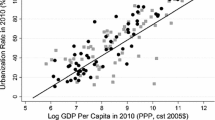Abstract
Germany is one of the most important exporters of manufacturing goods in the world, but by far not all manufacturing firms in Germany are exporters, and there is a remarkable gap between the share of exporters in all manufacturing firms between West Germany and East Germany. While in West Germany in 2004 about two in three manufacturing plants were exporters, fourteen years after re-unification this share was less than fifty percent in the former communist East Germany. Given that exports play a key role in shaping business cycles and growth in Germany, and the much higher unemployment in East compared to West Germany, promotion of exports by East German firms figure prominently on the policy agenda. However, the reasons for the large difference in the propensity to export between East and West German firms are not yet well understood, not least due to a lack of comprehensive micro data. Using unique new data and a recently introduced non-linear decomposition technique this paper shows that the huge difference in the propensity to export between West and East German plants can only partly be explained by differences in firm size, productivity, and technology intensity.
Similar content being viewed by others
Notes
In this paper the term firm is used to mean a local production unit, or plant.
The earlier version of this paper (Wagner 2007a) used wages per employee to proxy human capital as a determinant of exporting. While wages can be expected to be positively correlated with human capital, including wages per employee in a study with a focus on differences between export activities of East and West German firms does not make sense because East German firms are known to use a low wage strategy to establish their competitiveness. Differences in wages per employee between East and West German firms, therefore, do not reflect differences in human capital (alone), but also differences in the rates of return to human capital between East und West Germany. I am grateful to two anonymous referees to point this out.
Stata 9.2 and the program fairlie.ado were used for computations.
References
Bundesminsterium für Bildung und Forschung (2002) Germany’s technological performance 2001. Bonn
Blinder AS (1973) Wage discrimination: reduced form and structural variables. J Hum Resour 8:436–455
Cahuc P, Zylberberg A (2004) Labor economics. Cambridge and London
Fairlie RW (2006) An extension of the oaxaca-blinder decomposition technique to logit and probit models. J Econ Soc Meas 30(4):305–316
Institut für Mittelstandsforschung (2007) Die Bedeutung der außenwirtschaftlichen Aktivitäten für den deutschen Mittelstand. Bonn
Konold M (2007) New possibilities for economic research through intergration of establishment-level panel data of German Official Statistics. Schmollers Jahrbuch / J Appl Soc Sci Stud 127(2):321–334
Leber U (2002) Determinanten betrieblicher Exportaktivitäten im Verarbeitenden Gewerbe, In: Lutz Bellmann (Hrsg) Die ostdeutschen Betriebe in der internationalen Arbeitsteilung, Nürnberg, 31–44
Loose B, Ludwig U (2006) Export und Beschäftigung in der ostdeutschen Industrie – Ein betrieblicher Längsschnitt, In: Institut für Wirtschaftsforschung Halle (Hrsg), Beschäftigungsanalysen mit den Daten des IAB-Betriebspanels. 79–106
Oaxaca R (1973) Male-female wage differentials in urban labor markets. Int Econ Rev 14:693–709
Wagner J (2001) A note on the firm size – export relationship. Small Bus Econ 17(4):229–237
Wagner J (2007a) Why more West than East German Firms Export. Institute for the Study of Labor IZA Discussion Paper No. 2656, March
Wagner J (2007b) Exports and productivity: a survey of the evidence from firm-level data. World Econ 30(1):60–82
Wagner J (2007c) Exports and productivity in Germany. Appl Econ Quarterly 53(4):353–373
Zühlke S et al (2004) The research data centres of the Federal Statistical Office and the Statistical Offices of the Länder. Schmollers Jahrbuch / J Appl Soc Sci Stud 124(4):567–578
Acknowledgement
All computations were done inside the Research Data Centre of the Statistical Office of Berlin. Comments from three anonymous referees that lead to a thorough revision of an earlier version (Wagner 2007a) are gratefully acknowledged.
Author information
Authors and Affiliations
Corresponding author
Rights and permissions
About this article
Cite this article
Wagner, J. A note on why more West than East German firms export. Int Econ Econ Policy 5, 363–370 (2008). https://doi.org/10.1007/s10368-008-0119-7
Published:
Issue Date:
DOI: https://doi.org/10.1007/s10368-008-0119-7




